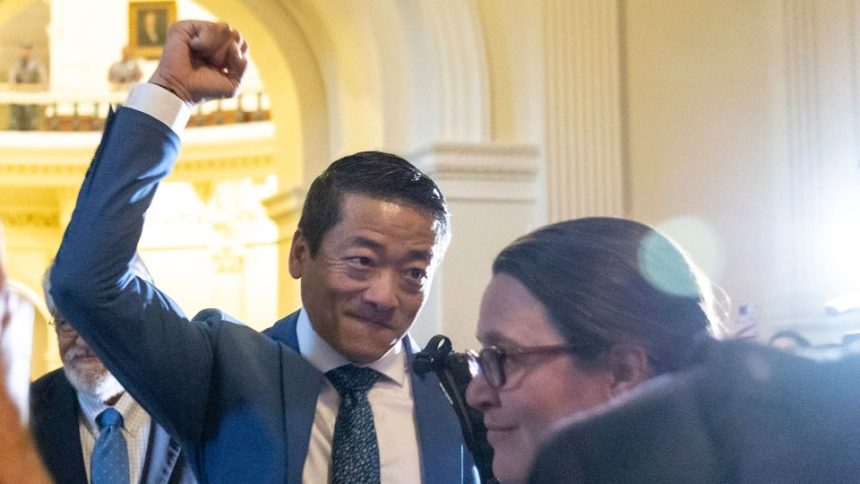Texas House Democrats who fled their state to stall a Republican redistricting effort returned on Monday, ending their 15-day holdout.
Democrats returned to Austin on Monday about an hour before the House was set to convene. And while they have vowed to keep fighting, their presence allowed the House to establish the two-thirds quorum that will be needed to advance new congressional maps in a push backed by President Donald Trump.
Shortly after House Speaker Dustin Burrows gaveled the House into session, he ordered the doors locked and said the Democrats who’d fled the state would be “released into the custody” of a designated Department of Public Safety officer, a move intended to ensure they will be on hand when the chamber reconvenes on Wednesday.
“We are done waiting. We have a quorum. Now is the time for action. We will move quickly and the schedule will be demanding until our work is complete,” Burrows said.
Democratic state Rep. Ramon Romero, who showed reporters his permission slip to leave the state Capitol, said, “This is the way the state does business.”
“Do you think if we weren’t gonna come back, we would’ve walked in here today? Absolutely not,” he said. “But we’re gonna become friends by the time this is over, we’re gonna have some good Mexican food together. I am gonna try to get away at some point or another.”
“I’m kidding,” he said.
Now that Democrats have returned to the Texas Capitol in Austin, the GOP-dominated legislature is expected to quickly advance new congressional maps aimed at creating five more Republican-leaning seats ahead of next year’s midterm elections.
The Texas House Redistricting Committee approved a congressional map that could net Republicans up to five US House seats with a vote of 12-8 on Monday evening. The map is slightly different than the one considered in the first special session. Trump backed the revised map after it was filed this afternoon. The map heads to the calendars committee next before moving to consideration on the House floor.
Texas Speaker of the House Dustin Burrows strikes the gavel as the House reaches a quorum. – Eric Gay/AP
Democrats had fled to blue states — including Illinois, New York and Massachusetts — as they faced civil arrest warrants pushed by GOP officials in Texas to force them back into the House chamber.
“We killed the corrupt special session, withstood unprecedented surveillance and intimidation, and rallied Democrats nationwide to join this existential fight for fair representation — reshaping the entire 2026 landscape,” said state Rep. Gene Wu, who leads Democrats in the Texas House.
“We’re returning to Texas more dangerous to Republicans’ plans than when we left. Our return allows us to build the legal record necessary to defeat this racist map in court, take our message to communities across the state and country, and inspire legislators across the country how to fight these undemocratic redistricting schemes in their own statehouses.”
Burrows told members that the House “has been through a tumultuous two weeks,” but said it will “remain a chamber where the majority has a right to prevail and the minority has the right to be heard.”
At Trump’s urging, Gov. Greg Abbott and Republicans who control the state House and Senate launched the effort to redraw the state’s congressional districts mid-decade — a break from most states’ typical practice of redistricting once a decade, after the completion of the US Census.
It’s part of the party’s effort to hold onto its narrow House majority in next year’s midterm elections — one that also includes lobbying GOP officials in Indiana and Missouri to change their maps to turn Democratic-held seats into favorable ground for Republicans, and could see the party add more GOP-leaning seats in Ohio, which is required by state law to redistrict.

Lawmakers recite the Pledge of Allegiance during a session as Democratic lawmakers begin returning to the Texas State Capitol in Austin, Texas, on Monday. – Sergio Flores/Reuters
The Texas effort has set off a nationwide gerrymandering arms race. In California, Democratic Gov. Gavin Newsom has vowed retribution, proposing a measure that would trigger new maps that could help Democrats pick up five more seats in the state — but only if Texas moves forward with its redistricting plan.
Texas House Democrats had laid out two conditions to return to the state. California would have to introduce its proposed new maps to neutralize the Texas effort, they said, and Burrows would have to adjourn the first special session Abbott had called. Both of those conditions were met on Friday.
Abbott called a second special session, which began immediately after the adjournment of the first one. But the House was blocked from doing business until enough Democrats returned to the chamber to provide the quorum required under its rules.
This week marks a flashpoint in an escalating and unprecedented fight over redistricting, with the country’s two most populous states taking center stage and control of the US House during the second half of Trump’s term potentially at stake.
California Democratic lawmakers could take just three days to advance new congressional maps intended to offset Republican redistricting efforts in Texas.
Legislation asking voters to approve the new maps is expected to be introduced Monday when lawmakers return to Sacramento from their summer recess, with final passage as early as Thursday, according to a person familiar with the Democratic planning. It will be heard in several committees along the way.
In pushing Texas and other states to redraw their congressional lines mid-decade, Republicans have undertaken extraordinary efforts to preserve their unified hold on power in Washington, prompting Democrats to consider equally unorthodox countermeasures.

Supporters for the returning Texas democrats chant as members enter the house at the Texas Capitol in Austin, Texas, on Monday. – Stephen Spillman/AP
Why are Texas House Democrats returning now?
Texas House Democrats have said they plan to fight the redistricting bill on the floor, laying out their case against the measure ahead of expected legal challenges in the coming months.
They argue they brought national attention to the GOP-led redistricting in Texas and helped create the momentum for California’s counteroffensive and calls in New York and other Democratic-led states to redraw their maps.
But their options to stop Republicans were always limited, short of staying out of Texas for the next year-plus. Republican Gov. Greg Abbott vowed that he would keep calling special sessions until the new maps passed.
Once a quorum is met, the legislative process to approve the congressional maps will kick off, including consideration in the redistricting committee and debate and votes on the floor. The state Senate, which passed a redistricting bill in the first special session, will go through a similar process. The Senate’s redistricting committee approved the map on Sunday night after holding a public hearing on the issue.
The GOP’s proposal would create five new districts friendlier to Trump and Republicans ahead of the midterm elections. It would likely force Democratic US Reps. Greg Casar and Lloyd Doggett to run against each other in a redrawn district.
GOP leaders have not laid out a timeline for final passage of the new map, but it could come as soon as this week.

CNN
What’s the situation in California?
When California lawmakers return from their summer recess on Monday, Democrats there will take the first step toward redrawing congressional boundaries to give them a greater chance at winning five additional seats — an extraordinary move intended to counteract Texas’ mid-decade redistricting.
Unlike in Texas, the legislation under consideration will also require voter approval to override a constitutionally mandated independent redistricting commission. Lawmakers will have to move quickly; the California secretary of state’s office gave the legislature a Friday deadline to make the November ballot, and bills must be in print for 72 hours before they can be voted on.
Democrats are expected to formally introduce the legislation Monday, with final passage pegged for Thursday. Because lawmakers are proposing to change the state constitution, two-thirds of each chamber must vote in favor of it to pass. Democrats hold three-quarters of the seats in both chambers.
The State Assembly returns at 1 p.m. PT (4 p.m. ET). The State Senate reconvenes an hour later.
California legislators will consider three bills this week. One is the constitutional amendment, which would temporarily instate the proposed map for the 2026, 2028 and 2030 elections. It would only take effect if another state chooses to redraw its maps and it would return the commission’s power after the 2030 election.
The second bill describes the proposed map, while the third calls the special election, provides for state funding and makes various timing and administrative changes to accommodate the vote and the potential for new districts.
The constitutional amendment requires a two-thirds vote in each chamber but doesn’t need Newsom’s signature before going before voters. The other two bills will need the governor’s signature and, in order to take effect immediately, will also require two-thirds majorities.
Can California Republicans stop Democrats in their state?
California Republicans, who have little power in Sacramento to slow the redistricting push, are nevertheless closely monitoring how Democrats proceed. GOP lawmakers are anticipating Democrats will put forward a package of legislative proposals that will not only advance the new maps but also outline how they intend to hold and pay for a statewide election in less than three months, a person close to the Republican caucus told CNN.
Gov. Gavin Newsom, a likely contender for the Democrats’ presidential 2028 nomination, is already planning for a statewide campaign to support a referendum. A victory could help Democrats win back the US House next year and give Newsom a boost in the next presidential primary.

California Gov. Gavin Newsom speaks at a press conference in Los Angeles on Thursday. – Mario Tama/Getty Images
But some significant opposition to the proposed referendum is already forming. Former Gov. Arnold Schwarzenegger on Friday posted a picture of himself working out while wearing a T-shirt that said “F*** the politicians/Terminate gerrymandering.” The caption read: “I’m getting ready for the gerrymandering battle.”
Charles Munger Jr., the son of the late Berkshire Hathaway vice chairman, has signaled he intends to fight the Democratic-led initiative. Munger spent more than $12 million in 2010 to entrench the independent redistricting commission in the state constitution, and he will fight any efforts to circumvent it, his spokeswoman Amy Thoma Tan said in a statement responding to California Democrats on Thursday.
“Two wrongs do not make a right, and California shouldn’t stoop to the same tactics as Texas,” Thoma Tan said. “Instead, we should push other states to adopt our independent, non-partisan commission model across the country. That’s how we can protect and defend democracy.”
Newsom’s approach has also led to a divide among good government groups that have traditionally opposed gerrymandering. While the League of Women Voters continues to urge California lawmakers to reject the redistricting push, leaders at Common Cause have said they will not proactively reject “counterbalancing” efforts done in response to other states. The group said Wednesday it would not oppose redistricting pushes that are proportional responses to other states, involve public participation and have a set expiration date, among other criteria.
Leaders at the organization said they would determine whether to oppose the California push after the full proposal has been released and judged against its rubric.
“We welcome the governor to adopt our fairness criteria,” said Omar Noureldin, the organization’s senior vice president of policy and litigation strategy. “And if the maps that are proposed in the process that’s laid out in its totality meet that fairness criteria, then we won’t oppose it.”
This story has been updated with additional information.
CNN’s Ethan Cohen contributed to this report.
For more CNN news and newsletters create an account at CNN.com









